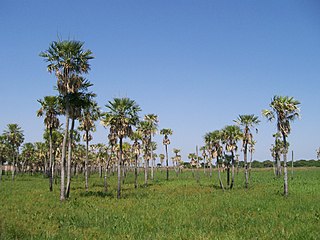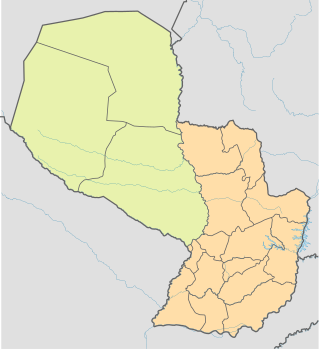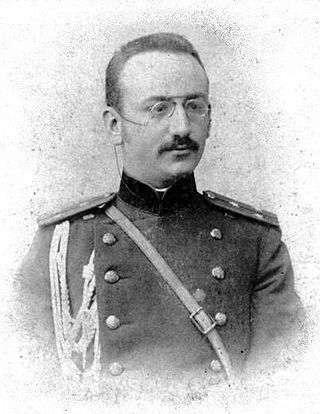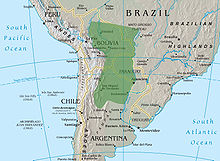
Chaco, officially the Province of Chaco, is one of the 23 provinces in Argentina. Its capital and largest city, is Resistencia. It is located in the north-east of the country.

The Gran Chaco or Dry Chaco is a sparsely populated, hot and semiarid lowland natural region of the Río de la Plata basin, divided among eastern Bolivia, western Paraguay, northern Argentina, and a portion of the Brazilian states of Mato Grosso and Mato Grosso do Sul, where it is connected with the Pantanal region. This land is sometimes called the Chaco Plain.

The Paraguayan Chaco or Región Occidental is a semi-arid region in Paraguay, with a very low population density. The area is being rapidly deforested. Consisting of more than 60% of Paraguay's land area, but with less than 10% of the population, the Chaco is one of the most sparsely inhabited areas in South America.

The Wichí are an indigenous people of South America. They are a large group of tribes ranging about the headwaters of the Bermejo River and the Pilcomayo River, in Argentina and Bolivia.

Guaycuru or Guaykuru is a generic term for several ethnic groups indigenous to the Gran Chaco region of South America, speaking related Guaicuruan languages. In the 16th century, the time of first contact with Spanish explorers and colonists, the Guaycuru people lived in the present-day countries of Argentina, Paraguay, Bolivia, and Brazil.
Matacoan is a language family of northern Argentina, western Paraguay, and southeastern Bolivia.
Guaicuruan is a language family spoken in northern Argentina, western Paraguay, and Brazil. The speakers of the languages are often collectively called the Guaycuru peoples. For the most part, the Guaycuruans lived in the Gran Chaco and were nomadic and warlike, until finally subdued by the various countries of the region in the 19th century.

Mataguayo–Guaicuru, Mataco–Guaicuru or Macro-Waikurúan is a proposed language family consisting of the Mataguayan and Guaicuruan languages. Pedro Viegas Barros claims to have demonstrated it. These languages are spoken in Argentina, Brazil, Paraguay, and Bolivia.
The Mocoví language is a Guaicuruan language of Argentina spoken by about 3,000 people, mostly in Santa Fe, Chaco, and Formosa provinces.

Spanish is the language that is predominantly understood and spoken as a first, or second language by nearly all of the population of Argentina. According to the latest estimations, the population is currently greater than 45 million.
Wichí Lhamtés Vejoz is a Mataco-Guaicuru language of Argentina and Bolivia. Speakers are concentrated in northern parts of Chaco, Formosa, Salta, Jujuy Provinces, as well as west of Toba, the upper Bermejo River valley, and Pilcomayo River. The language is also called Mataco Vejoz and Vejos.
Caquinte, also Poyenisati, is an Arawakan language of Peru. It is spoken along the Poyeni, Mayapo, Picha, Yori, and Agueni rivers, with some speakers along parts of the Sensa and Vitiricaya rivers, within Junín, Peru. It is an endangered language.

The Ayoreo are an indigenous people of the Gran Chaco. They live in an area surrounded by the Paraguay, Pilcomayo, Parapetí, and Grande Rivers, spanning both Bolivia and Paraguay. There are approximately 5,600 Ayoreo people in total. Around 3,000 live in Bolivia, and 2,600 live in Paraguay. Traditionally nomadic hunter-gatherers, the majority of the population was sedentarized by missionaries in the twentieth century. The few remaining uncontacted Ayoreo are threatened by deforestation and loss of territory.
Katembri–Taruma is a language family proposed by Kaufman (1990) that links two extinct or critically endangered languages of South America:
Enxet, also known as Enxet Sur or SouthernLengua, is a language spoken by the Indigenous southern Enxet people of Presidente Hayes Department, Paraguay. It is one of twenty languages spoken by the wider Gran Chaco Amerindians of South America. Once considered a dialect of the broader Lengua language, Enxet and Enlhet diverged as extensive differences between the two were realized.

Indigenous peoples in Paraguay, or Native Paraguayans, include 17 ethnic groups belonging to five language families. While only a 1.7% of Paraguay's population is fully indigenous, 75% of the population identifies as being partially of indigenous descent; however, the majority do not identify as being indigenous but as Mestizos. Most of the native population lives in the northwestern part of the country, the Gran Chaco.
The Wichí languages are an indigenous language family spoken by the Wichí in northwestern Argentina and far-southeastern Bolivia, part of the Matacoan family. They are also known as Mataco, Wichi, Wichí Lhamtés, Weenhayek, Noctenes, Matahuayo, Matako, Weʃwo. The name Mataco is common but pejorative.

Juan Belaieff was a Russian and Paraguayan cartographer and soldier, notable for his investigation and mapping of the Gran Chaco region and for his role in the Paraguayan army during the Chaco War.
The Chaco linguistic area is a linguistic area that includes various South American language families and isolates of the Chaco region of South America, in southern Brazil, southeastern Bolivia, Paraguay, Uruguay, and Argentina.










